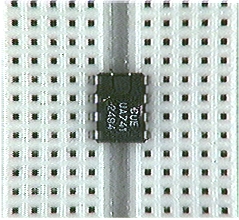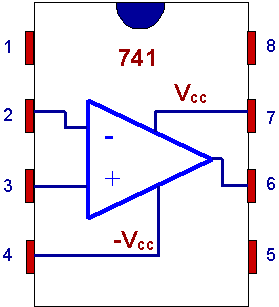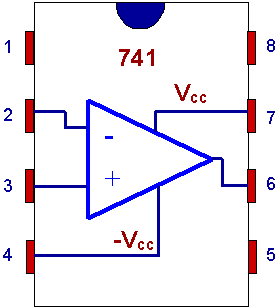Why Are Operational Amplifiers Widely Used?
This
lesson is the first lesson on operational amplifiers, or op-amps as they are
often called.
Operational amplifiers are widely used in signal processing circuits, control
circuits, and instrumentation. Of all analog integrated circuits, the
operational amplifier is the analog integrated circuit which has the most sales
and is the most widely used in the widest variety of electronic circuits.
If you are an electrical engineer, you will probably encounter more operational
amplifiers than any other integrated circuit device. It's an important
component for electrical engineers who design circuits using them and to all
other kinds of engineers who use measurement and control circuits that contain
operational amplifiers.
Where do you find Op-Amps?
Operational amplifiers are used in many places including:
-
In strain gage circuitry to
measure deformations in structures like bridges, airplane wings and I-beams in
buildings.
-
In temperature measurement
circuitry for boilers and in high altitude aircraft in a cold environment.
-
In control circuits for
aircraft, people movers in airports, subways and in many different production
operations.
The
operational amplifier is a versatile component that can do many things in
measurement, signal processing and control. That versatility is the
largest reason that you find so many operational amplifiers being used!
Your Goals
Your
goal for this lesson should be:

Given an operational amplifier you want to use,

Be able to connect the positive and negative power supplies correctly.

Be able to locate the inverting and non-inverting input terminals.
The 741 - A Typical Operational Amplifer
This is
a computer photograph of an operational amplifier. It's often referred to
as an operational amplifier. We've called this module "The World of
Op-Amps" because these creatures can be found almost everywhere you find
electronic circuits. Here is a typical operational amplifier on a circuit
board.

This
particular operational amplifier is an integrated circuit. Most
operational amplifiers today are integrated circuits, even power operational
amplifiers that can be used to drive small motors. Of course the actual
size is smaller than the picture above!
Look carefully at the operational amplifier. It's important to notice that
there is a notch (sometimes a circular depression) on one end (the "top" of the
chip in the picture) of the operational amplifier. The pin shown below the
notch is pin 1, and the one above is pin 8. They're numbered counter
clockwise around the chip. Here is a drawing of the pinout

Above is a drawing of the pin-out.
What is an Op-Amp Really?
An
operational amplifier is a high gain, differential, voltage amplifier.
-
It is a
voltage amplifier. The input is a voltage and
the output is a voltage.
-
The
gain is high. Typically, the gain is over
100,000
-
It is a
differential amplifier. It actually amplifies
the difference between two voltages.
When Did Operational Amplifiers Arrive On The Scene?
Operational amplifiers have been around since the late '40s or early '50s.
There have been a number of influential and interesting characters that worked
with operational amplifiers including George Philbrick and Bob Widlar.
Using Operational Amplifiers
If you
want to use an operational amplifier, you will need to know several things.
-
You will need to know how to
power up
a chip. In other words, you need to know how to get the power supply
connected so that you can use the chip. If you don't get the power supply
connected the chip will not operate as an amplifier.
-
We'll spend a little time
looking at those connections.
-
You will need to learn about
circuits that use operational amplifiers. That's the topic of the next
lesson in this series.
Examine
the pinout for the chip. Normally, the chip will either be inserted in a
circuit board, or wired into a printed circuit board. In either case, to
power the chip you need to make two connections:
-
The positive voltage from the
supply to pin 7 on the chip.
-
The negative voltage from the
supply to pin 4 on the chip.
-
If you are used to using logic
chips where the power goes to the corners, that's not quite what you have here.
It's different and be sure you get it right.
Every
operational amplifier will have some power supply connections. Often they
are not shown on the circuit digram for a circuit you are designing. When
necessary they are shown as below. Here, Vcc is the positive supply
voltage. Usually, Vcc is 12 to 15 volts. A negative
supply is usually needed also, although there are operational amplifers on the
martket that operate well just from a positive supply. The negative
supply, -Vcc, is usually in the range from -12 to -15 volts. When
two supplies are used, they are the same voltage and of opposite sign in almost
all cases.

Often
an integrated cirtcuit chip has a single operational amplifer. The symbol
for such an operational amplifier is shown below. There are three voltages
associated with this symbol. Each voltage here is measured with respect to
ground.

-
Vout is
the output voltage,
-
V+ is
the non-inverting input voltage,
-
V- is
the inverting input voltage.
The chip diagram shows how an operational amplifier
is connected internally in a typical 741 integrated circuit chip. Notice
that the voltages noted above are the actual connections you will need to make
to use the amplifier. They are not part of the power supply circuitry
which is separate.
Remember that the operational amplifier is a high gain, differential voltage
amplifier. In this case the output voltage is a very large multiple of the
input voltage. The multiplying factor is called the gain. For a 741
operational amplifier, the gain is at least 100,000 and can be more than a
million (1,000,000). That's an important fact you'll need to remember as
you put the 741 into a circuit.
You
don't need to know much more about wiring the operational amplifier or the
internal connections to the amplifier. There are some minor adjustment
connections you could make, but you're probably OK for now.
You
still need to learn about operational amplifier circuits. That's the next
lesson, and you're ready to move on to it. The lesson is the one on
Inverting Amplifiers.
|

